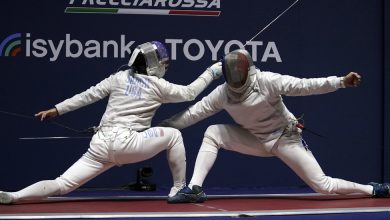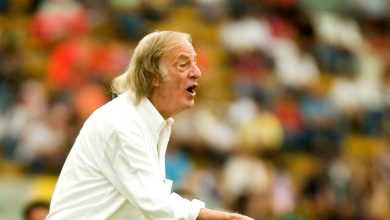He Was Compared to Tiger Woods. So Why Did He Walk Away From Golf?

A young man is walking briskly across a stretch of mowed grass, on his way to someplace entirely new. Hundreds of people are clapping as he passes. They are hollering his name. The young man lowers his head, tugs off his white cap and holds it in the air. A smile flickers across his face, then disappears.
This is Anthony Kim. It is 2008, and he is 22 years old and one shot away from earning his first win in a first professional golf tournament. When he reaches the 18th green, he pauses, not only to line up his final putt, but also, he later reveals, to let a simple fact swirl into his consciousness: My life is about to change. Kim taps the ball, and it clunks into the cup. He punches the air twice, screams “Yes!” twice. He takes a bow.
He is $1.2 million richer.
“That walk up 18 was the best feeling in my entire life,” he says later that day.
“I want to recreate that as many times as possible now.”
The feeling would prove fleeting. Four years after that first win, after more rousing victories that established him as one of golf’s biggest stars, Kim took a sudden leave from the game. Injuries were hampering his play, and he needed time to heal. But beyond his physical troubles, some invisible, unknowable forces must have been churning inside him.
Because he never came back.
‘Golf’s Yeti’
A full decade after Kim stopped playing professional golf, people are still fascinated by him, still asking where he is, still curious if he might ever return.
They wonder, in part, because of his talent. His power, his touch, his moxie — they were a recipe for sustained greatness. More than that, though, they wonder because he never bothered to explain himself. In a world of interminable retirement tours and heart-tugging valedictory speeches, Kim walked away in 2012 without saying goodbye and has made almost no public appearances or utterances since.
Kim was supposed to be the next Tiger Woods. Instead he became the sports world’s J.D. Salinger. Sports Illustrated called him “golf’s yeti.” Pictures and stories hinting at his whereabouts regularly go viral on social media. Last summer, when the new LIV Golf circuit began recruiting players with huge, guaranteed sums of money, many people’s minds went to the same place: Could Kim, still just 37, be coaxed back to the game?

Anthony Kim celebrated his victory at the Wachovia Championship in Charlotte, N.C., in 2008. It was his first professional win.Credit…Chuck Burton/Associated Press
Sports careers are rare and valuable. They are hard won, involving years of tedious and often lonely practice. And they are fragile, susceptible to the ravages of age and injury. Most athletes, for these reasons, tend to treasure them.
Kim’s total retreat, then, stirs all kinds of questions about sports and celebrity: What duty does a person have to his God-given talent? What does that person owe to his fans? And in the age of TMZ and T.M.I., what does it mean, really, to disappear?
‘He Was Transcendent’
Kim was born and raised in Los Angeles, the only son of South Korean immigrants. Though his golf swing would come to appear effortless, his skills were intensely honed during his childhood years by his father, Paul, and a string of coaches. By the time Kim reached college, he could make a golf ball do whatever he wanted.
“His talent was beyond anything I had ever seen before,” said Rocky Hambric, an agent who signed Kim after his three years at the University of Oklahoma. “And I know it’s sacrilege, but that includes Tiger Woods.”
Two months after that first PGA Tour win came a second. It was only his second year on the tour, but he was operating with the prowess of a veteran. He finished the 2008 season with eight top-10 finishes, $4.7 million in winnings and a tornado of hype.
That Kim emerged just as Woods was navigating the first real turbulence of his career — in the form of injuries and marital turmoil — heightened speculation about whether he could be the game’s next superstar.
And the highlights, for a little while, kept coming. On the second day of the 2009 Masters Tournament, in a stirring display of his daredevil approach to the game, Kim fired off 11 birdies, setting a tournament record that still stands.
In a traditionally staid sport, Kim often felt like a gate-crasher, providing surprising bursts of flair and color.
He demolished two-dimensional stereotypes about both golfers and Asian Americans. He wore garish belt buckles bearing his initials. He talked trash — and backed it up. He had an admitted love of partying. He was gregarious with fans and generous with his time and money. He signed a multimillion dollar endorsement deal with Nike. He spoke often about wanting his own reality show.
“He was transcendent and attracted interest from all segments of sport, music and entertainment, which was especially rare for golf at the time,” Chris Armstrong, another former agent, said in a text message.
In a span of a few weeks in 2010, he appeared on “The Jay Leno Show,” where he gave the actress Jessica Alba a putting lesson, and played in the celebrity game at the N.B.A.’s All-Star weekend, where he was matched up against the comedian Chris Tucker.
“I’d rather have 50 people love me and 50 people hate me,” Kim said in an interview with ESPN in his rookie season, “than have 100 people who don’t even know who I am.”
At some point during this ascent, Kim took out an insurance policy on his body. When injuries forced him to step away from the game, he began receiving monthly checks that reportedly would cease if he returned to competition. The payout, according to a Sports Illustrated article from 2014 that cited anonymous sources close to Kim, landed somewhere between $10 million and $20 million and was the primary reason, they said, for his prolonged absence.
Yet there has remained something unsatisfying about that line of reasoning. Few other golfers relished the simple act of competing as much as he so plainly did.
Near the end of the 2008 season, in a performance that cemented his status as golf’s most exciting young player, Kim trounced Sergio Garcia, the Spanish star, in the opening singles match of the Ryder Cup, a prestigious team competition. Kim swaggered around the course all day, feeding off the energy of the clamorous crowd.
“I wouldn’t trade this for $10 million,” Kim said that day.
At the Range With Tommy Chong
Kim last spoke publicly about his golf career in 2015, three years after he left the game.
In an interview with an Associated Press reporter, he confirmed that he was receiving insurance payments, but he denied that the money was the reason he was not returning to competition. He also shot down more fanciful rumors, including one that he was homeless.
He said he needed time to rehabilitate an assortment of injuries, including to his ankle and back. He was hiring a new trainer. In all, he sounded optimistic, saying he was happy with his progress. “My goal right now for the next year is to get healthy,” he said.
Communicating through friends, Kim declined to be interviewed for this article.
Those who know him say he splits time between Texas, California and Oklahoma. He became a father in 2021 and got married last summer. He has broad investments, including in real estate. He and his wife own The Collective, a popular food hall in Oklahoma City.
To answer a question on everyone’s mind: Kim plays golf, but only sporadically. Adam Schriber, who has been Kim’s swing coach since he was a teenager, said in an interview that he played twice with Kim in the past two years.
“It’s the same swing you remember,” Schriber said.
Eric Larson, Kim’s caddie from 2008 to 2009, fondly recalls splitting a couple buckets of balls some years ago at a public driving range in Los Angeles with Kim and Tommy Chong, of Cheech and Chong fame, whom Larson befriended during their overlapping stints in federal prison.
In an interview, Larson said that he had asked Kim on the phone recently about whether he would participate in the LIV Golf tour. Kim demurred.
“He goes, ‘I don’t know. I really don’t know.’ ” Larson said. “I said, ‘Come on, man, get the old clubs out. Go out there and have some fun.’ And he starts laughing at me. He goes, ‘That’s what everybody wants me to do!’”
Anthony Kim Sightings
There is a point where talent, at its most rarefied levels, starts to feel collectively owned. The dynamic is pronounced in the sports world, where people use the first-person plural form to refer to their favorite teams, where athletes return the favor by winning championships for the city and dedicating awards to the fans.
This can explain why, for sports fans, there is something so disconcerting about watching a star player walk away at a young age. When talent feels like a winning lottery ticket, squandering it can be processed almost as a betrayal.
Consider Bjorn Borg, who was one of the top tennis players in the world in 1983 when he retired, seemingly out of the blue, at 26. The decision bewildered his fans, but Borg’s justifications hinted at an often unseen tension: that success in sports can close as many doors as it opens.
“Basically, over the years, I was practicing, playing my matches, eating and sleeping,” he told The New York Times in 1983. “But there’s other things besides those four things.”
Borg explained his decision. What Kim has done — to walk away and become entirely inaccessible to an adoring public — feels different and extraordinary, particularly at a time when name recognition has never held more value.
He is hardly in hiding — today it seems a person can be deemed a recluse or misanthrope for merely declining to maintain a social media account — but still, any evidence of him engaging with society in even the most banal way tends to inspire wonderment.
In 2019, Ben Bujnowski, 48, a technology sales consultant from Great Falls, Va., was on vacation with his family when he spotted Kim outside a Los Angeles restaurant. A longtime golf fan, Bujnowski could not resist circling back to say hello, and Kim gladly obliged his request for a picture.
Bujnowski posted the photo to Instagram — “AK sighting in the wild,” he wrote — where it was soon picked up and circulated by the golf news media. The comments section of the original post became a message board of sorts for strangers to post their own sightings of Kim.
In this way, each public photograph of Kim inspires its own little news cycle: Kim crouched in a group photo in somebody’s backyard; an inadvertent shot of the back of his head at a bar; an unintentionally cryptic Instagram post from Schriber. In 2018, No Laying Up, a golf media company, posted a brief video of Kim, surrounded by at least six dogs, expressing support for Phil Mickelson before his exhibition match against Woods (“Need to see him holding today’s paper,” somebody tweeted in reply).
“It almost feels like his life story in golf hasn’t been completed yet,” said Bujnowski, who sometimes gets recognized on the street by golf fans. “People want to know what happened.”
A Carefree Summer
The sports world craves neatly legible narratives. But Kim’s path offers a reminder of how frequently the industry’s most common tropes — the underdog stories and redemption arcs, the last shots and legacies and love of the game — fall short of capturing the complexities of the people who inhabit it.
Fans may want their heroes to stay in their assigned roles, but there are gifted people everywhere turned off by the relentless pursuit of external validation. And failure, in the eyes of others, may represent freedom for the individual.
Kim hinted at a possible worldview in a 2009 interview with Golf Digest, when he responded to question about his apparent fearlessness on the course by deflating its very premise.
“It’s just golf,” he said.
Some close to Kim can recall moments that seemed to foretell his eventual ambivalence toward his golf career.
Larson, Kim’s former caddie, thinks back to the week after the 2008 Ryder Cup. Kim led the field by two strokes after two rounds at the Tour Championship. But that Saturday, in the third round, his momentum spiraled. He hit only four fairways. One of his tee shots struck a fan, sending him to the hospital with a head wound. Kim slumped to a tie for third place.
Larson was sure that Kim imploded because he had, somewhat inexplicably, gone out late that Friday night.
“I don’t know what he thought, but you don’t just go out and party all night Friday night when you’re leading the Tour Championship.” Larson said. “That would have been his third win that year, but we ended up losing that tournament by a shot, and he was out Friday night, late, and I’m just like, ‘What are we doing?’”
Schriber, the swing coach, recounted another moment that, in retrospect, felt loaded with meaning. It was 2010, the night after what turned out to be Kim’s final PGA Tour win, at the Houston Open. Schriber and the rest of Kim’s team were on a private jet to Georgia happily passing around a bottle of tequila, but Kim seemed withdrawn.
“We were just getting pummeled celebrating — because winning’s hard — but he didn’t even drink after the win,” Schriber said. “He said, ‘Schribes, I don’t feel anything, I don’t feel the joy.’”
A week later, Kim finished third at the Masters.
Schriber is reluctant to speculate too much on his friend’s mind-set, but, in his view, Kim’s childhood and the continually rocky relationship he had with his father had a deeper and more lasting effect on Kim than most realized.
The story of how Paul Kim tossed one of his son’s second-place trophies in the trash is part of Anthony’s lore. Later, when Kim was in college, he and his father had a fight that resulted in a two-year stretch of silence between them. After Kim turned professional, his father publicly acknowledged that he was too hard on his son, that he was too cold, that when other parents asked him how to mold their children into top athletes, he advised them against it.
Schriber doubted that golf, even during Kim’s loftiest moments, was the respite the young man needed it to be.
“I think it was the feeling of, ‘It’s not taking the pain away like I hoped it would,’” Schriber said.
Schriber was also there when, in his eyes, Kim got an early glimpse of an alternate path.
It was 2006, the summer after Kim left college. He was staying at Schriber’s house in Traverse City, Mich., laying the foundation of a golf career, practicing every morning and sleeping on a couch in the living room at night. In the afternoons, stuck in a sleepy town with few other options, he hung out with Schriber’s children, kayaking, fishing, hiking and doing all manner of other activities that he, as a child golf prodigy, had rarely had time to enjoy.
That September, Kim played in the Valero Texas Open, his first PGA Tour event. He tied for second, won nearly $300,000and soon after moved into an upmarket condo in Dallas. But he never forgot those lazy days in Michigan, when nobody knew who he was and life felt pleasantly small.
“Best summer of my life,” Kim said often, according to Schriber.
Susan C. Beachy contributed research.




